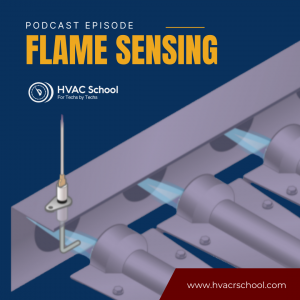Flame “sensing” – Short 136

In this short podcast, Bryan explains the basics of flame sensing, also known as flame rectification.
Flame sensing/rectification is a form of proving flame. When you can’t prove flame, your furnace might be dumping unspent gas into the heat exchanger, which can cause an explosion.
Flame sensing rods are common in hot-surface (HSI) and intermittent-spark (ISI) ignition. These rods stick out into the flame and connect to the furnace board. The flame creates a path between the rod and ground, which allows a very small current to flow to the board. Without a flame, there is voltage but no path, so the board can’t sense a current and will shut the gas valve off to try again.
Sensing rods can fail when they short out due to a cracked insulator, are physically broken, aren’t placed in the flame, or get covered in silica or carbon. If the furnace or burner assembly isn’t properly grounded, then the flame sensor also won’t work.
Flame sensing rods are often confused with thermopiles or thermocouples; the latter devices generate voltage and have a coating that can rub off with improper cleaning. Flame sensing rods don’t have either of these features, so you can clean these by any means necessary (without breaking them or creating grooves or pits).
To test a flame sensing rod, begin by making sure the furnace is properly grounded. Then, make sure the rod is in the right spot and that the burner assembly is in good order. Get a microamp meter (with a resolution that reads tenths of microamps). Then, connect your leads in series with the flame rod.
If you have an iPhone, subscribe to the podcast HERE, and if you have an Android phone, subscribe HERE.
Check out our handy calculators HERE.
Check out information on the 2022 HVACR Training Symposium at https://hvacrschool.com/symposium/.
Author:









Comments
To leave a comment, you need to log in.
Log In